Country estate Hoog Beek and Royen
Iedere zaterdag en zondag rijden wij om ongeveer 07.15 uur vanaf ons huis aan de Prinses Marijkelaan via de Arnhemse Bovenweg naar buitenplaats Hoog Beek en Royen.
Every Saturday and Sunday we drive from our house on Prinses Marijkelaan via the Arnhem-se Bovenweg to country estate Hoog Beek en Royen at approximately 07.15. The Arnhemse Bovenweg is a section of the ancient connecting road from Cologne to Utrecht, which was traditionally called Heerweg or Bovenweg. Starting at the farmstead De Blaauwe Schorteldoek in de Bilt (Schorteldoekse-steeg) to the border with Driebergen. In 1826, the current Oude Arnhemseweg, the 1e and 2e Hogeweg and the Arnhemse Bovenweg were described as “De Oude Arnhemse Weg”. On 24 April 1895, this road - which crosses several districts - was divided into four. The Siberiëweg, the section from Laan van Beek en Royen to the border of Driebergen was renamed Arnhemse Bovenweg in 1920.

Hoog Beek en Royen was originally part of the Beek en Royen estate. The original house of this estate at 2e Dorpsstraat 54-58 still stands there. The name Beek en Royen is a combination of the names of the founder Hendrik Verbeek (1707-1788) mayor of Utrecht and member of the Utrecht regent patriciate and his wife Clara J. van Royen.
After his death, the heirs sold Beek en Royen to Albert Voombergh (1793-1851), Head of the Amsterdam Bankers' House Ketwich en Voombergh, around 1825. He had his country estate Hoog Beek en Royen built on the front part of the large forest area, which is known to the older Zeist residents as the mayor's residence. From 1956 to 1979, the house was used as the official residence of the mayors Mr. Aleid Pieter Korthals Altes and Mr. Dr. Andries Antonius Henricus Stolk.
The estate is bordered by the Driebergseweg, Laan van Beek en Royen and Arnhemse Bovenweg and is located approximately 300 metres to the right after the sign “Welkom in Zeist” when coming from Driebergen, before the intersection of Laan van Beek en Royen, Dorpsstraat and Lageweg.
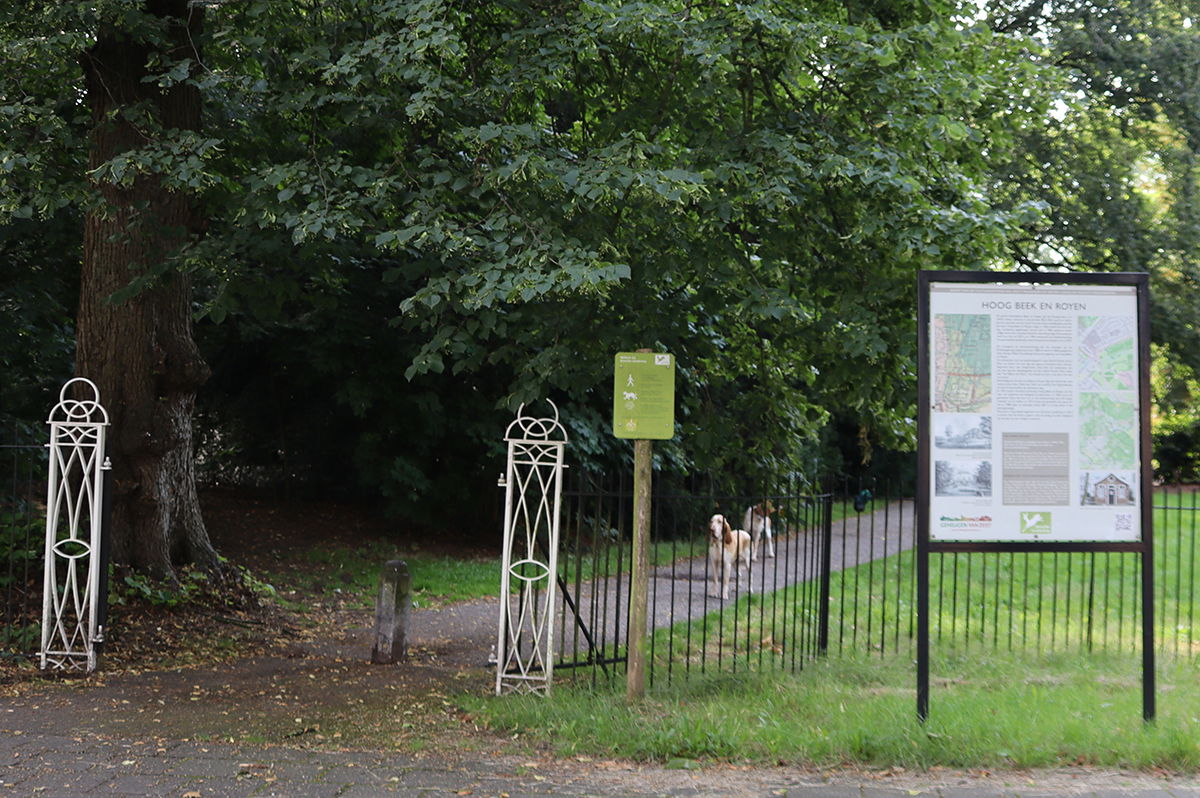
Via the entrance gate on the Laan van Beek en Royen I walk along a narrow path that is lit by old lanterns in the autumn. I leave the path next to the oak tree on my left and continue walking. Everywhere you see tall and stately old trees that border the lawn, but you also see tall rhododendrons that bloom beautifully in red, purple and white in the spring. There are trees throughout the park that were brought from Boskoop when the estate was built in 1825. Plane trees, red and green beeches, summer oaks, chestnuts, lime trees, tulip trees and many more.
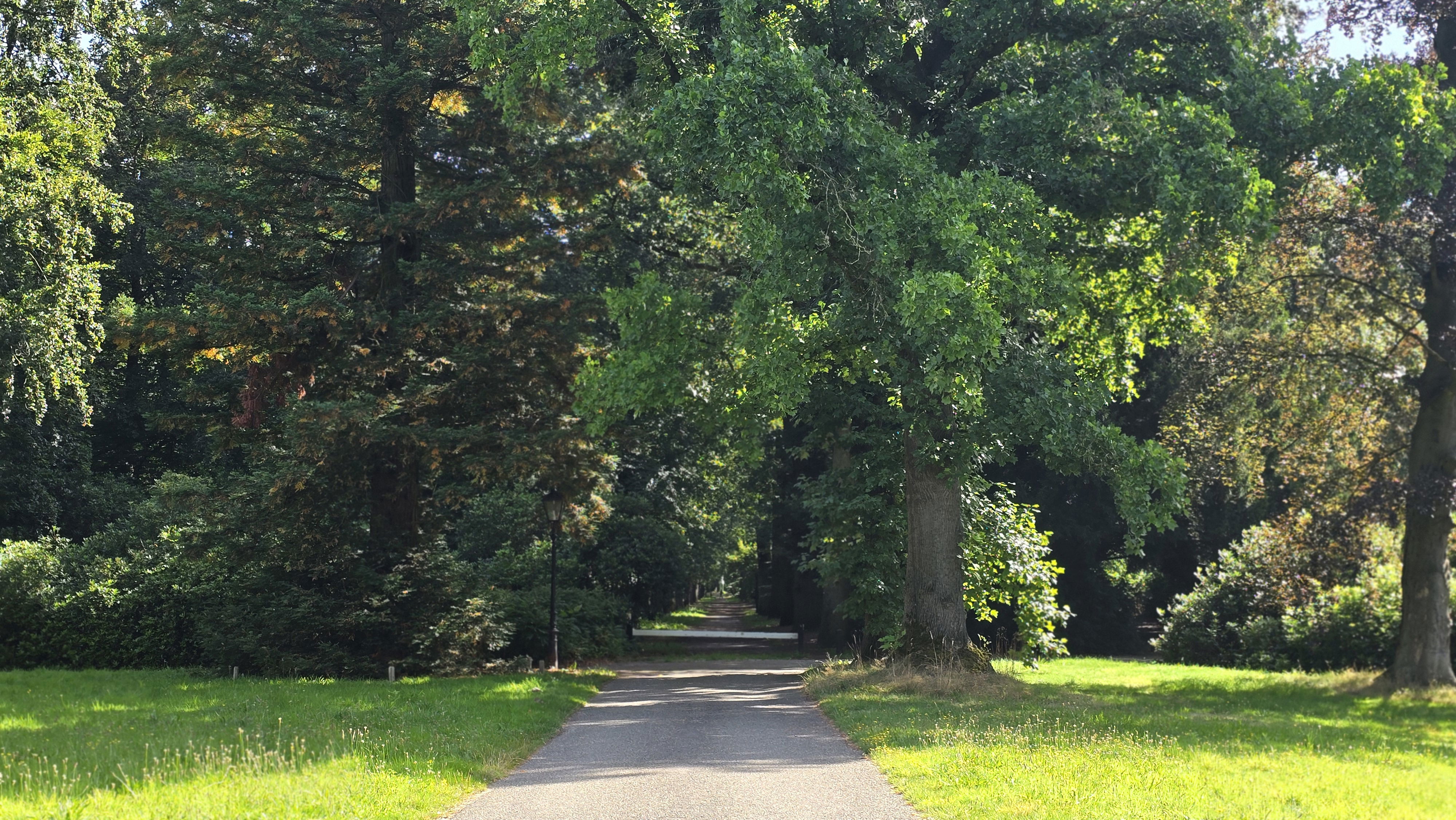
At the intersection of paths I cross the Kippenlaantje (origin of name unknown) that runs parallel to the Laan van Beek en Royen. This lane, dating from 1750, was originally a public road and is one of the oldest oak lanes in the Netherlands. Opposite the Kippenlaantje, the access road to the Driebergseweg runs on the right and about ten meters further on, on the left, a meandering path runs around the pond. On the other side of the Driebergseweg and at the end of the winding pond, lies the former orangery that is now used as office space.
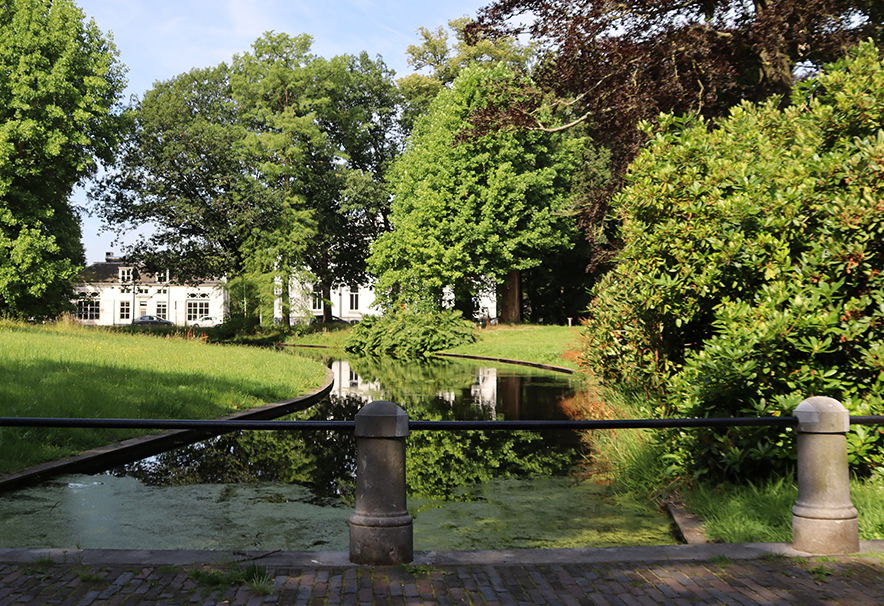
In front of me lies an old stone bridge with hard stone poles on either side with steel tubes in between. The hard stone poles on the bridge were smashed a few years ago and the steel tubes had been pried out and bent and/or disappeared. During the weekend, young people hang out here in the evenings and at night, out of sight of cameras in the Dorpsstraat, drinking themselves into the drink and being able to do their thing. This is evident from the number of empty beer and liquor bottles, cigarette boxes, crown caps, plastic, cigarette butts, tissues and other nasties that I clean up here every week.
There are many fish in the pond and a variety of water birds can also be seen here. For example, I see the mallard, runner duck, moorhen, coot and with some regularity the Canada goose, mute swan, cormorant, grey goose, Egyptian goose and a fishing blue heron that also likes a duck or coot chick. I hear and see birds everywhere but I miss the sparrow. In my younger years, many species of sparrows died out that pecked at the edge of your plate at restaurants such as the Jagershuis and pancake restaurant Rhijnauwen. It was a plague. But now the many species of sparrows such as the house sparrow, tree sparrow, hedge sparrow and whitethroat seem to be almost extinct. There I hear the green woodpecker and every now and then, if I'm lucky, I see it too. Those are truly moments of happiness. Furthermore, I see but hear, hidden by the dense foliage, mainly the ring-necked parakeet, buzzard, jackdaw, crow, great tit, tawny owl, blue tit, crested tit, robin, thrush, blackbird, blackcap, marsh tit, wren, nuthatch, tree creeper, stock pigeon, wood pigeon, magpie, goldcrest, jay, long-tailed tit, white wagtail, chiffchaff, crossbill, great spotted woodpecker and occasionally a linnet, hawfinch, hawk, sparrowhawk, goldfinch or brambling. There are many more bird species here and too many to mention.

On the right across the bridge, on a green hill, is the house that has housed Van Lanschot Kempen bankers since 2001, with the coach house to the left in the distance. The hill was created with the sand that was released when the winding pond was dug. But before my walking friends arrive, I first walk around the house, as I have done for many years. At the front of the house is a beautiful swan bench that I saw there 50 years ago. It is amazing that it is still so intact, but it could do with a clean-up now.
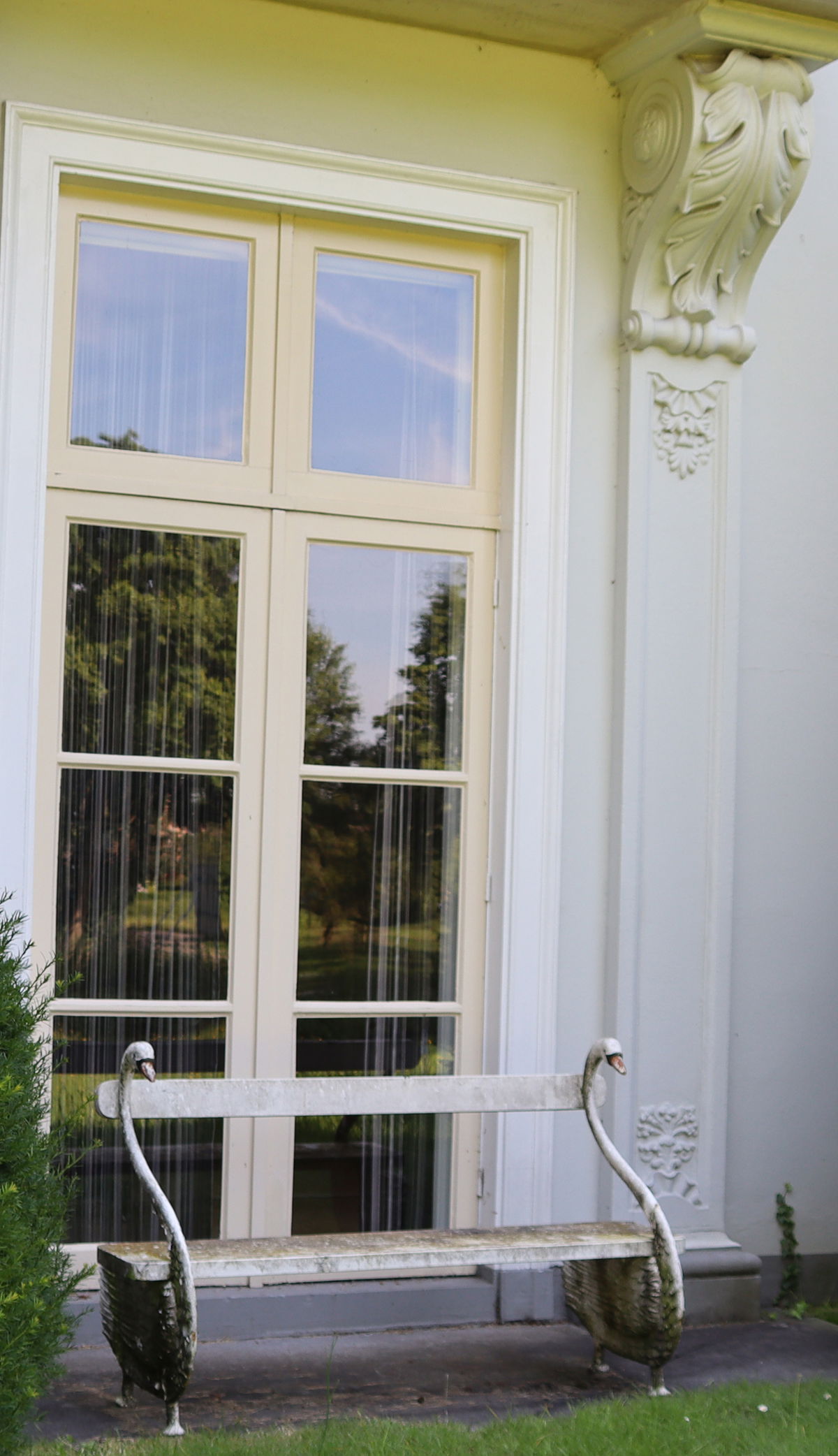
I continue via the back of the house to the coach house with coachman's house. The coach house has served as the bank's office space in recent years. The exterior is painted white and yellow and there is some green deposit on the facade. When I peek inside, I see that it looks empty and neglected. It is a shame that the maintenance of these types of buildings is not a priority for companies. This is different for these types of houses inhabited by private individuals. They are busy every day with the maintenance and management of their pleasure and burden in order to preserve it for the future, their heirs and us.
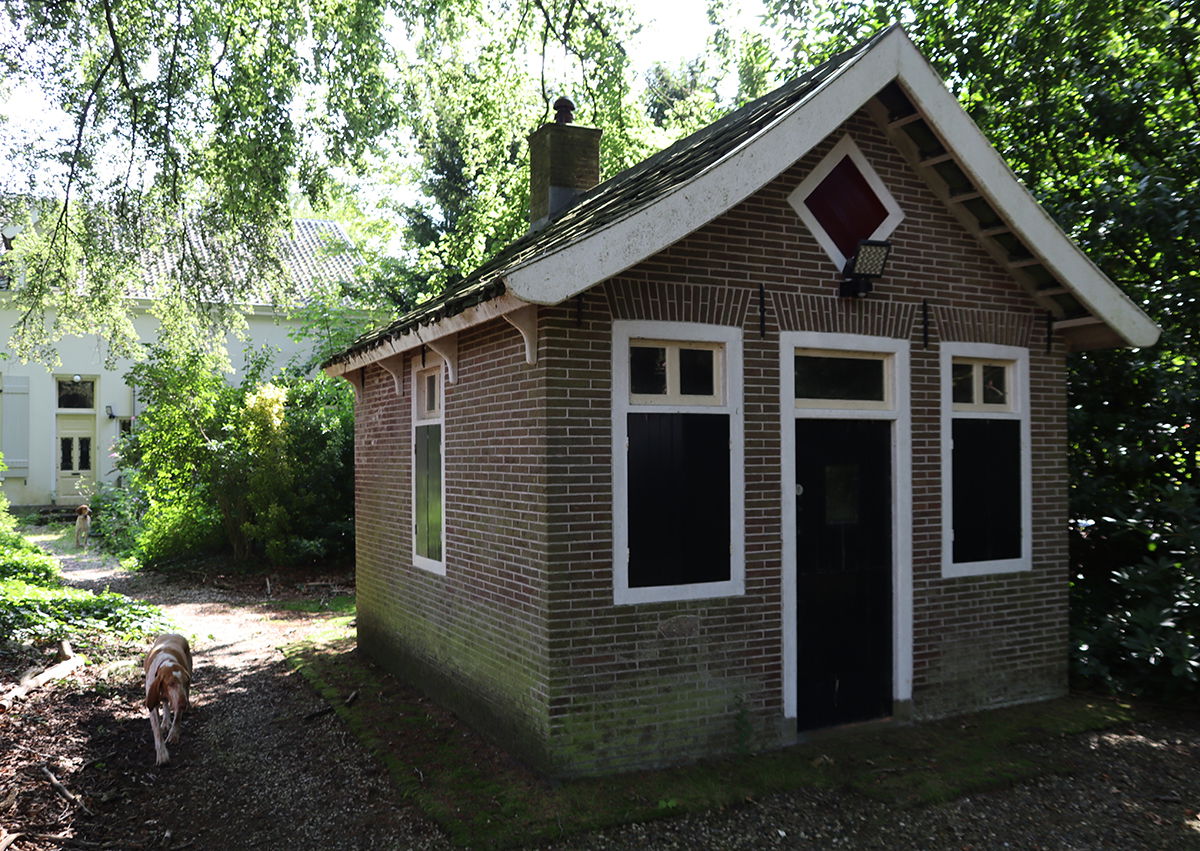
The playhouse that stands in front of the coach house and to the right of the house was built around 1830.
Ada Beets, the youngest daughter of the famous 19th century writer and poet Nicolaas Beets, was born on 12 April 1871. She spent a number of summers with her parents and two older sisters Aleida and Dora at the country estate Hoog Beek en Royen in Zeist. They stayed with the dowager Van Loon-Voombergh and her daughters the gentlemen Agnes and Louise. In her memoirs ‘Youth in the Beetsenhuis’ Ada describes the farmhouse: ‘At breakfast, the lady says: “Ada certainly wants to go to her house this morning, come and get the key from me later”. I got the key and went with my mother to ‘the little house’. Close to the stable, hidden behind the bushes, stood a small, ivy-covered farmhouse. In front of it was a garden with phloxes, dahlias, delphiniums and a pump. Mother unlocked the door, an upper and lower door, and then you stood in an old Dutch room with a stove, a glass cabinet with crockery, a drawer with tableware and kitchen towels, a white sanded folding table, lots of copper on the white walls and everything, everything that belongs in a kitchen. The shutters were opened and I took possession of my house with joy! I immediately put on my neat farmer’s outfit, took buckets and brooms, sponge and rag and started cleaning diligently, of course in clogs, while mom sat on the bench in the garden. That was a delight every day’, according to Ada Went-Beets in her book.
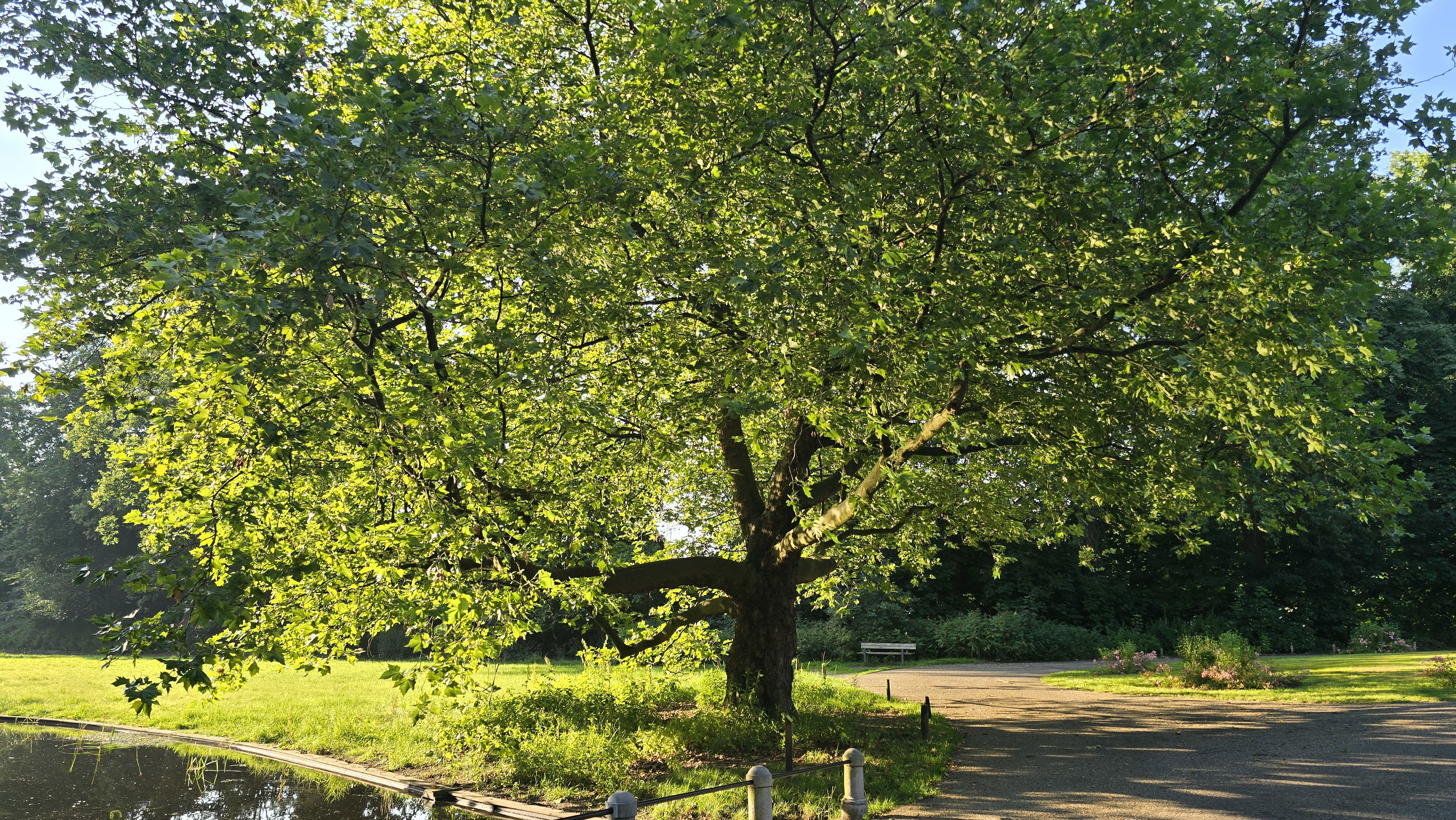
Then I walk back to the back of the house to see who of my walking friends with dogs are there and we greet each other and our dogs warmly. Sometimes there are four of us but often there are two or three of us and we walk from the enormous tulip tree on the left over the bridge at exactly 8:00 am. Bailly the English Setter, Harco the Vizsla, Gijs the Jack Russel and Siena and Giulia my Bracco Italiano’s (Bracchi) expect a dog biscuit from us first and they greet each other and us as if it has been months since we have seen each other.
Forest rangers and Boas
Our conversations and also those of dog owners we meet have been remarkably often about forest rangers and Boas of Het Utrechts Landschap in the past year. Indignation everywhere about closed areas, only being allowed to walk or sit on paths and not on unfenced meadows, expansion of leash areas, swimming bans for dogs and the arrival of the wolf in our already busy Zeist. Also, receiving a fine of € 109,- without prior warning (including € 9,- administration costs) for violating suddenly changed and poorly communicated rules is discussed. Like a few weeks ago. In front of Het Huis by the bridge we were talking to a female passer-by with a dog. I said to my walking friends, look guys there comes a car from the Utrechts Landschap. The car drove over the bridge in front of the house, turned around the lawn and stopped next to us. The forest ranger who was in it opened the window, greeted us with a good morning and asked if this was an organised walk. We said in unison, no, this is a chance meeting. For organised walks you have to request written permission from Het Utrechts Landschap. But we do not walk organised, we see who is there that day at 08.00 at the latest and then walk away. Almost all of us are members of Het Utrechts Landschap and keep the park and forests clean of litter. Yes, here in Hoog Beek en Royen I collect a bag full of empty cigarette boxes, drink containers, bottles, bottle caps, plastic, cigarette butts and tissues every week. Mostly from young people who are on a pub crawl in the Dorpsstraat and can do their thing out of sight of cameras.I also clean up a lot of mess on the lawn, but I can be fined there because I am not allowed to deviate from the paths. Strange because far from the paths in the unfenced meadow there are signs hanging on chestnut wooden fences by the water that our dogs cannot read and that invite the walker to walk over to read what is written on them. It is because I have a warm heart for nature and that this organization also does a lot of good work, because otherwise I would immediately cancel my membership of Het Utrechts Landschap.
During the walk we talk about personal joys and sorrows, ailments of growing old, football, holidays, local, national and world politics and our opinions about them. But also jokes to each other and there is a lot of laughter. We are there for each other. Like last week.
One of my walking friends is badly endowed with hair and is, so to speak, bald. We talked about aggressive crows and seagulls that can poop and peck enormously. He told me that he had once been attacked with food in his hand by a whole flock of seagulls who had it in for his food and tried to peck him on the head. I said with a serious face that you apparently become very bald from that. He looked at me, saw my twinkling eyes and said that they must have pecked him a lot. We walked on laughing.
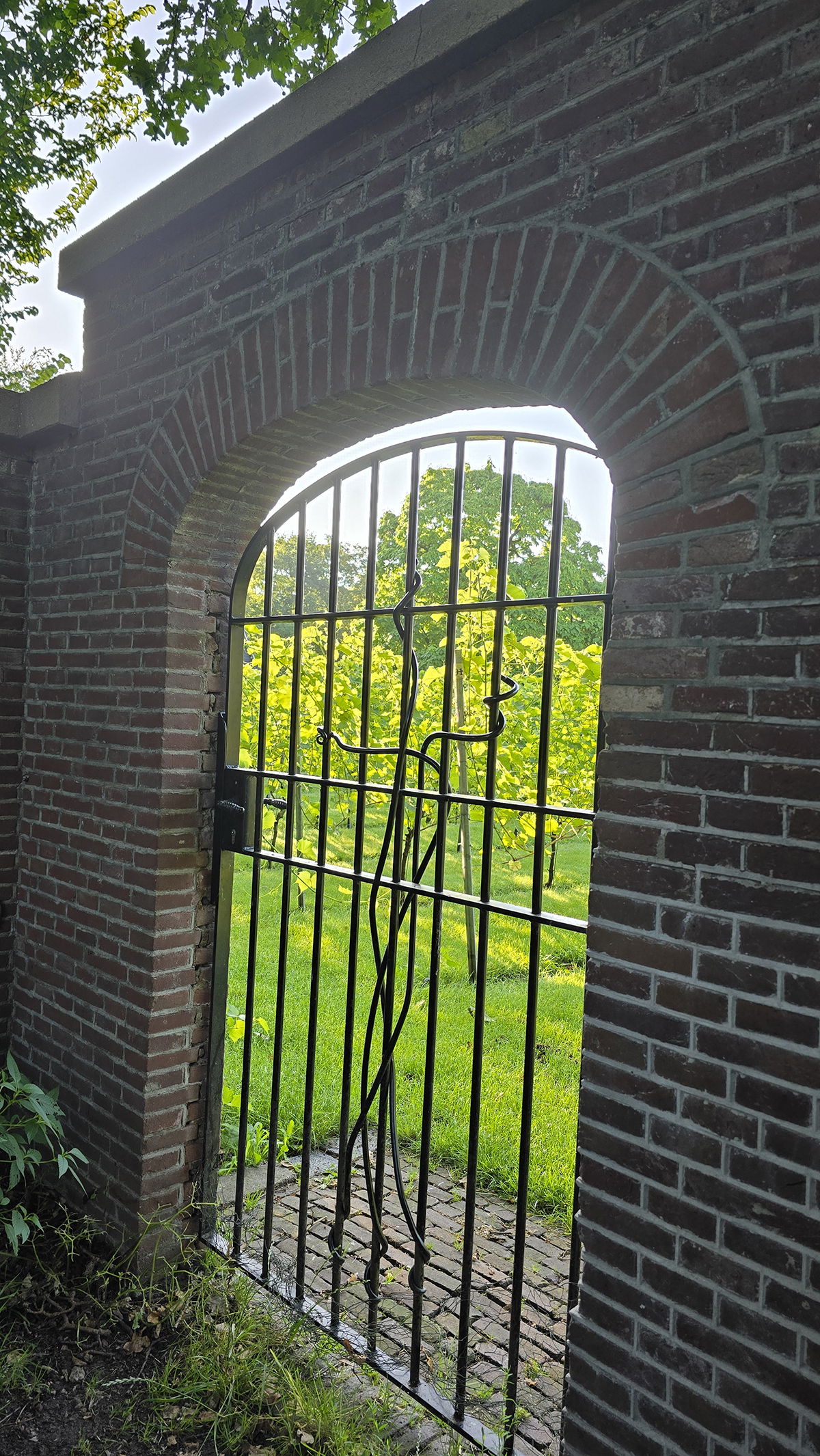
We walk along the meadow with the long arched vegetable garden wall from 1830 on the right, which is currently being restored. Where behind this wall vegetables and flowers used to be grown in greenhouses for the residents of the country house and many types of fruit trees stood, Het Utrechts Landschap, together with Rotary, created a vineyard in 2012. I still remember that behind the wall and also in the meadow opposite there were sheep and many other cattle. In 2004 the animals and fencing disappeared and from then on we walked through the gate over the meadow and could sit wonderfully under the high and wide Catalpa that you can see standing there on the left looking through the gate and over the wall. Every year at Pentecost, friends of mine held their family reunion under this impressive trumpet tree with heart-shaped leaves, white and purple flowers and long legumes.
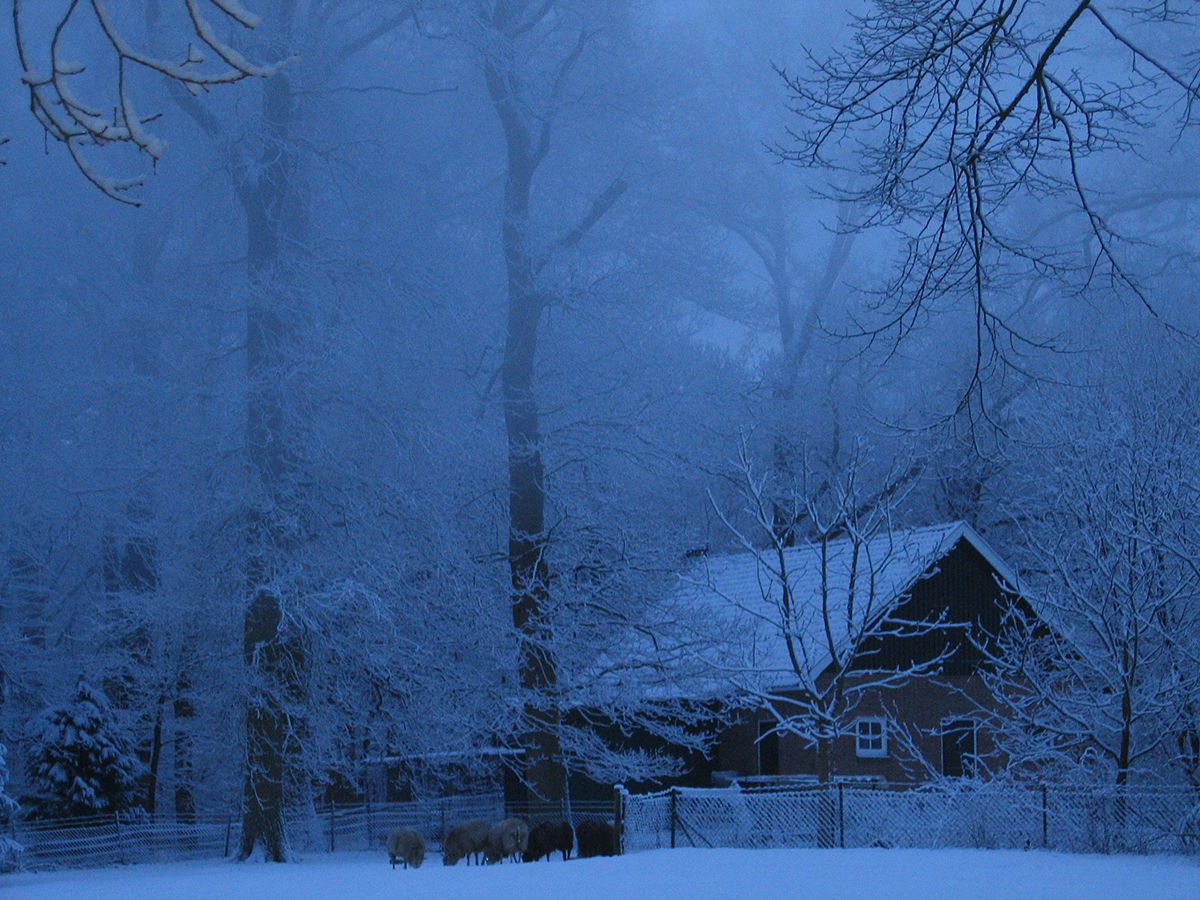
About twenty years ago I met an old gentleman who asked me, do you know what kind of tree this is? Yes, I said, that's a Catalpa. He, they also call it a Civil Servants' Tree. When asked why Civil Servants' Tree, I had to remain silent. He told me that the Catalpa comes (blooms) late and goes early. Haha.
Further to the left, until 2012, stood the former gardener's house, which I only know as an animal shelter (photo 2008). Within the fence with a bone pit, sheep, goats and chickens walked around, which were lovingly cared for every day by Roel, a friendly and wiry man with long hair in a ponytail. The story goes that the animal shelter had to disappear because the Rotary wanted to place a wooden shelter behind the vegetable garden wall at the current vineyard and two buildings did not fit within the zoning plan of Hoog Beek en Royen.
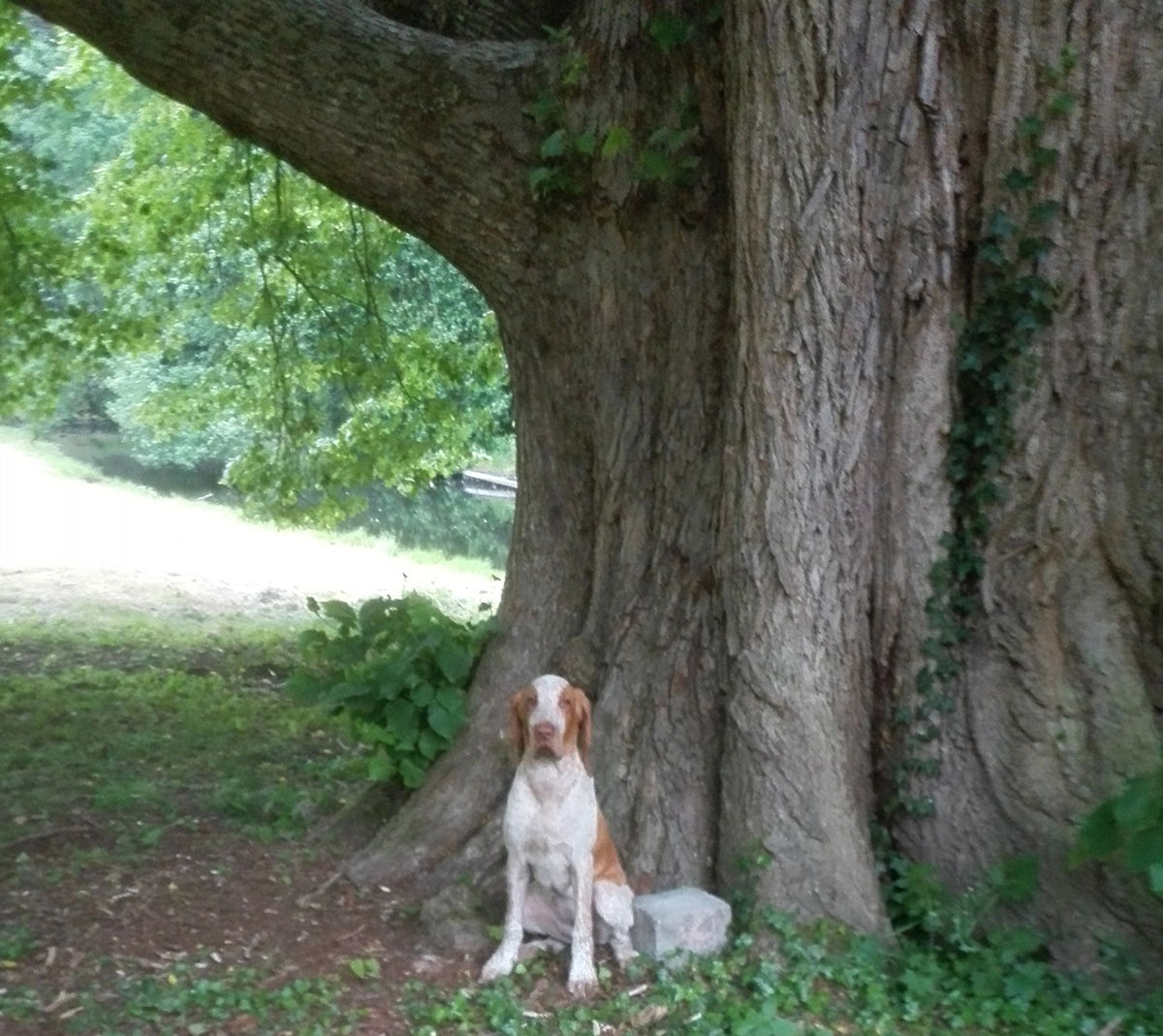
I sat under this tree every day with our dear and faithful Bracco Italiano “Luna” waiting for my walking friend Yvonne, who unfortunately passed away much too early in 2016, and her dog Tress.
Opposite the animal shelter by the water, there was an enormous linden tree of about 220 years old until the beginning of 2022. During the February storm Eunice, the tree was blown over. The lower part has been put upright again and see the tree is sprouting again. For protection, a chestnut wooden fence has been placed around the tree.
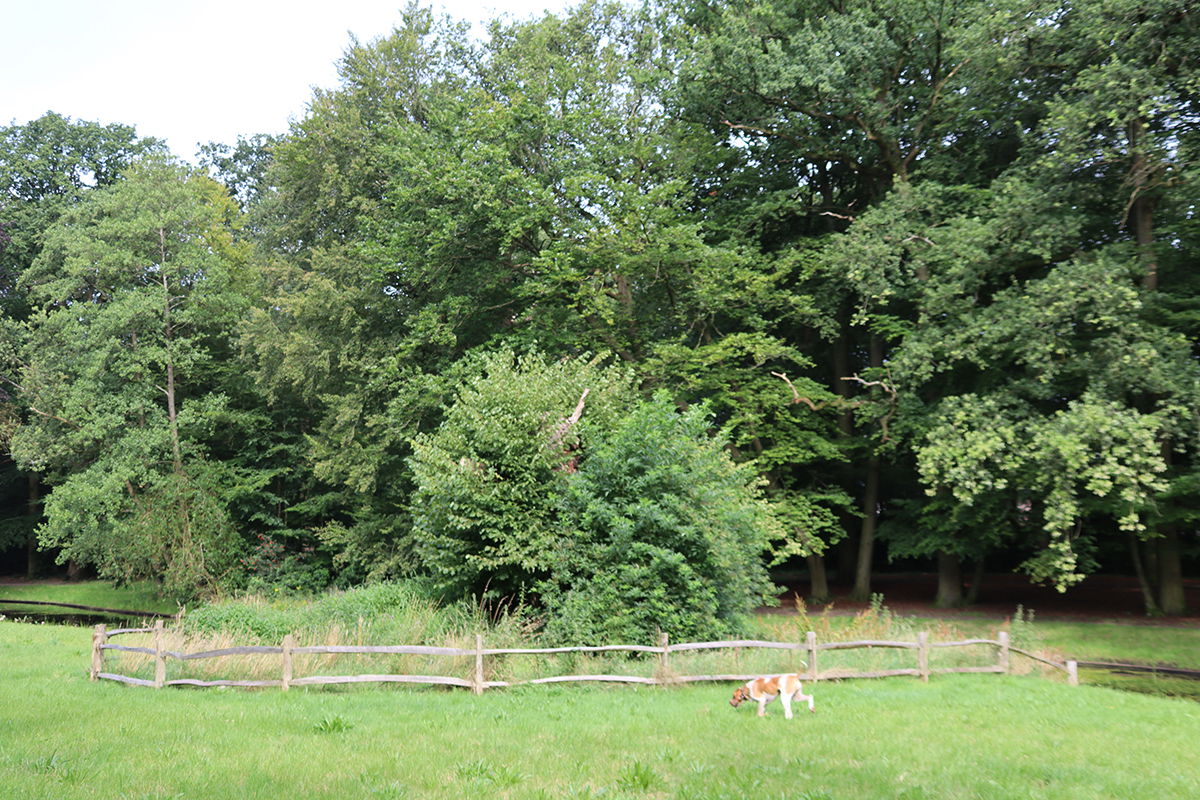
Past the Rotary house, we turn right to the large field opposite the Sparrenheuvel office complex. In the past, there were five benches on this large field where many of us could sit in peace and quiet, but now there is only one.
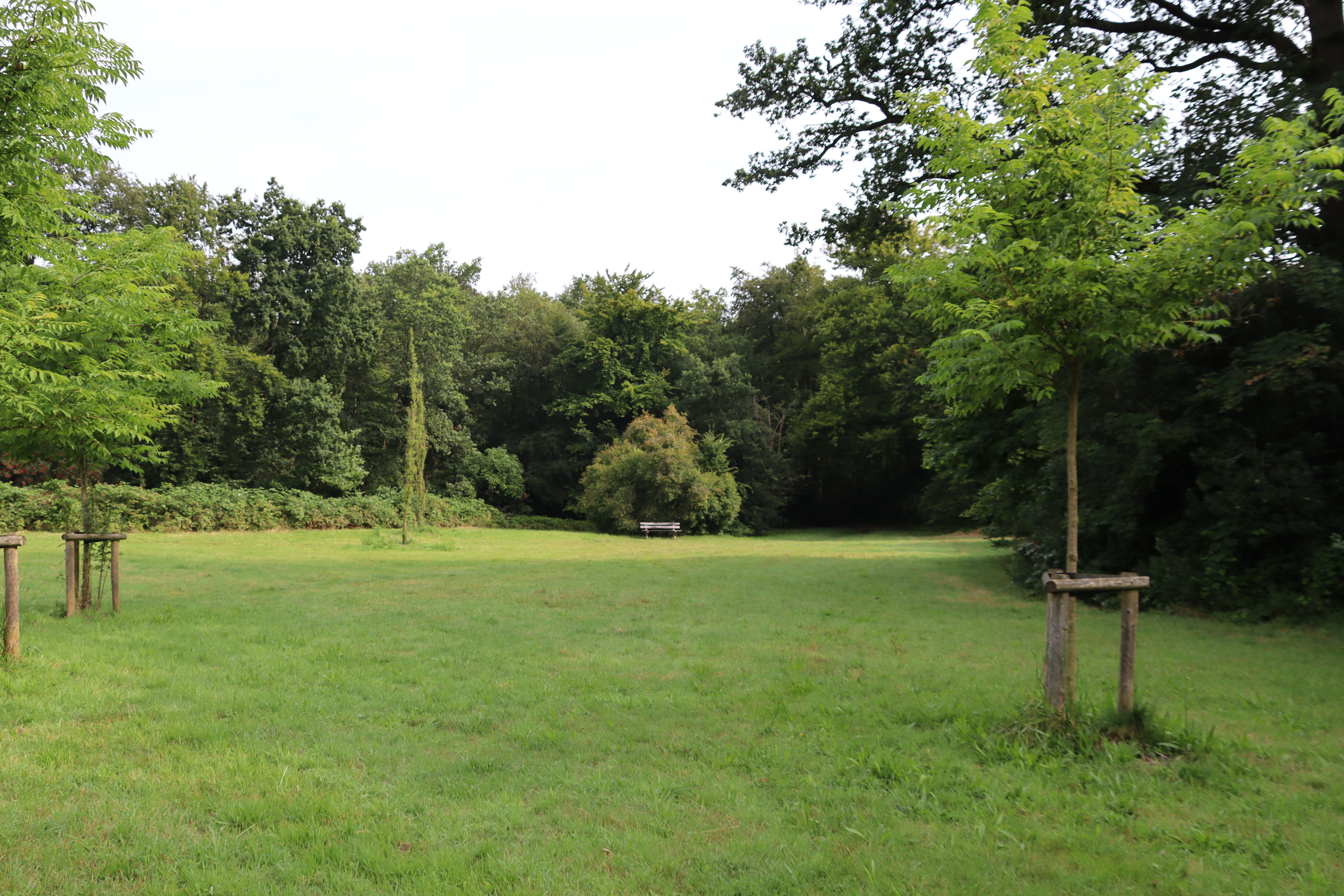
The dogs can play around with each other for a while and we enjoy the sun that we haven't seen much of this year. You can feel the warmth in your body, wonderful. You also see a lot of dead wood and dying old trees on this country estate. To the left of the field were old beech trees in which a pair of black woodpeckers had a nest about twenty years ago. From the bench I could see every day how mom and dad flew back and forth to feed their young and how later the young flew out. The black woodpecker is rare, but this week I saw and heard them again in the Molenbosch. That was lucky, wasn't it?
We continue our way behind the nursing home de Amandelhof along the water and pass beech trees in which I once saw two tawny owls sitting next to each other on a branch.

Then we come to the wooden bridge to cross the water. This bridge was also completely demolished a few years ago and was then rebuilt by a, you might say, "inspired" wood artist. On the ends of the bridge he used wood in which you can recognize animal heads with a bit of imagination. On the left I see a male boar (boar) and on the right a fox. Do you see them too? You should go and have a look yourself because you can also recognize animal heads on the other side of the bridge.
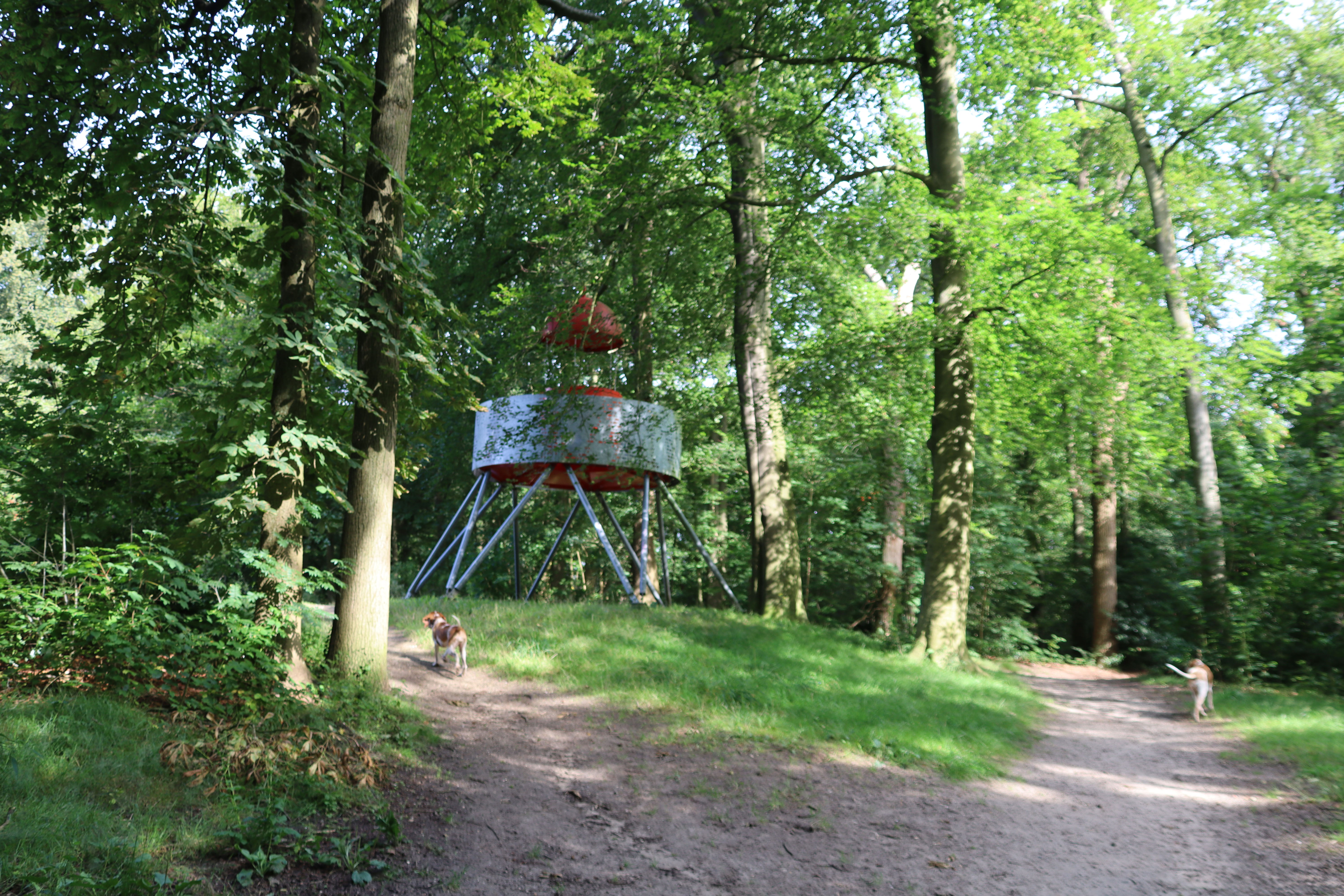
Then further left a bend upwards where there used to be a tea house on a small hill from where you had a beautiful view over the meadow to the country house and where I could shelter from rain, hot sun and wind. A mortal shame that un-abandoned people set fire to the tea house and that on that same spot according to the floor plan of the tea house in 2009 that ugly red lighthouse the beacon “Zeist aan Zee” was replaced. According to scientists, if the rise in sea level continues, the new coastline of the Netherlands will probably be located near this point. Zeist aan Zee will then be a fact.
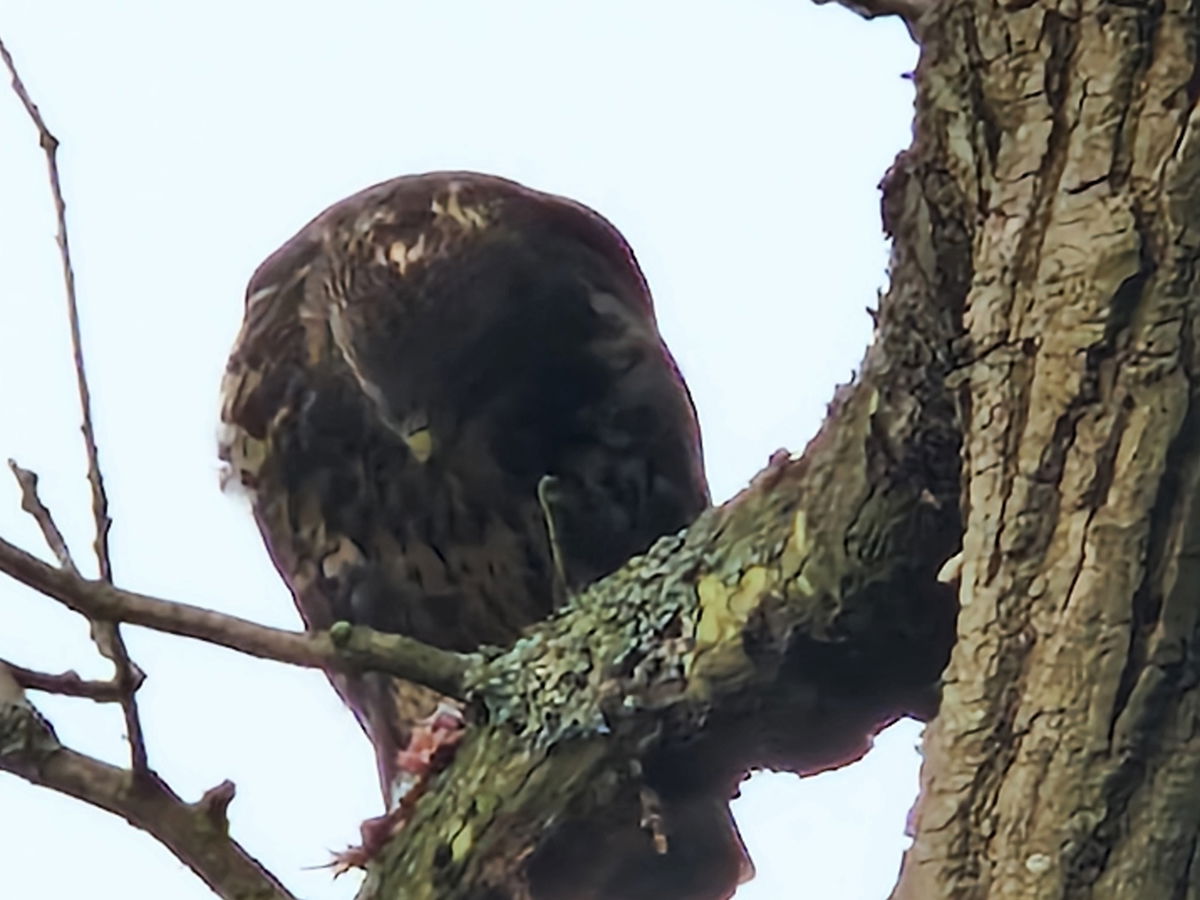
Last week I heard a warning call from a buzzard high up in a tree on the other side of the field near the dead beech on the right and the response of a young one. I looked around and saw the young one eating a bloody prey on a branch a meter or two above me. The fact that I was standing so close to the young one with the parent close by was not a pleasant thought and with goose bumps on my arms I walked on quickly. That parent would see a tasty morsel in me.
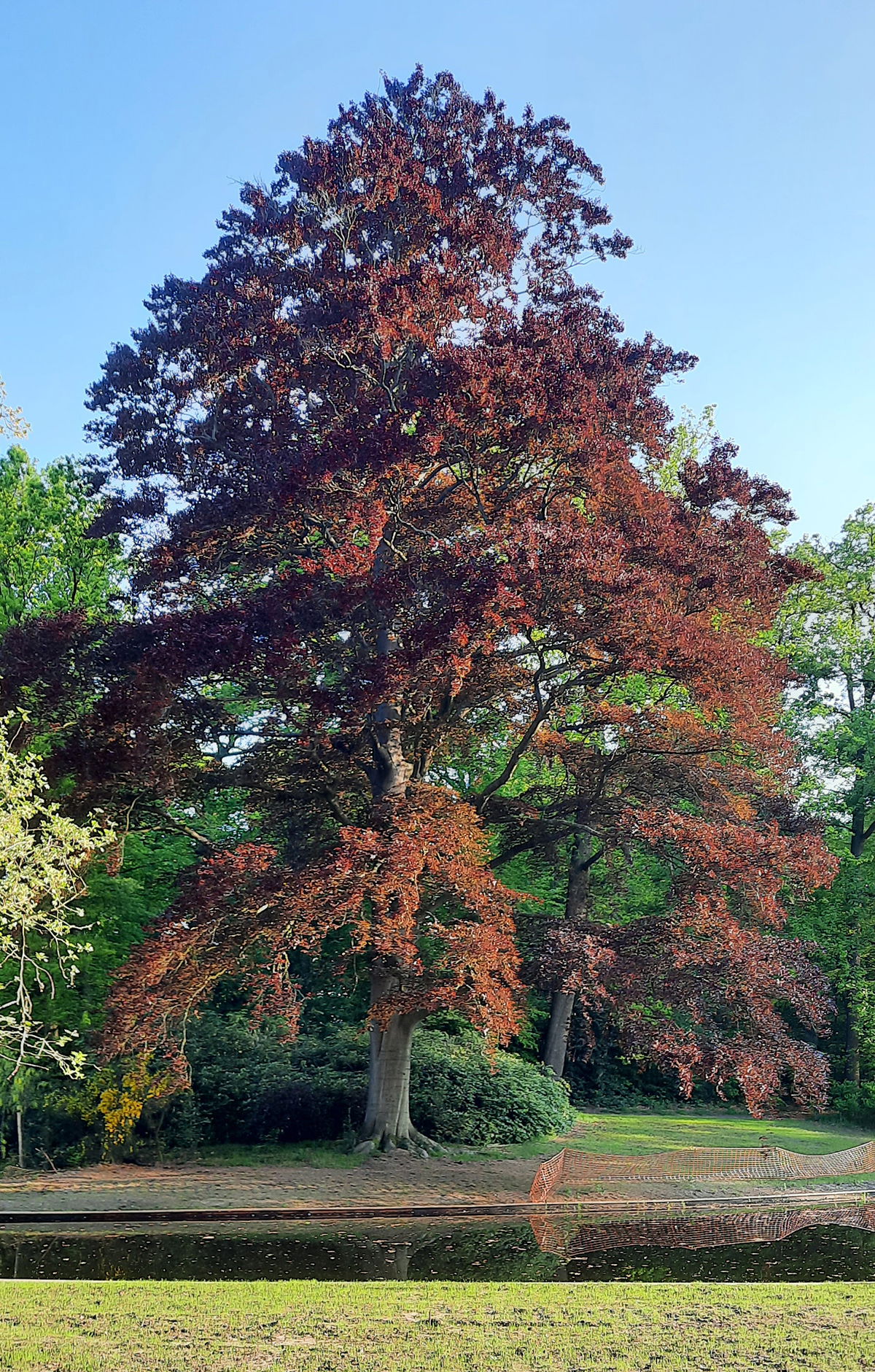
We are now almost at the end of our walk and walk along a piece of winding pond where a whopper of a red beech is on the left and we are at the end point at the bridge. The dogs get a biscuit as a farewell and we wish each other a nice day and with a see you tomorrow or otherwise see you next week everyone goes their own way.
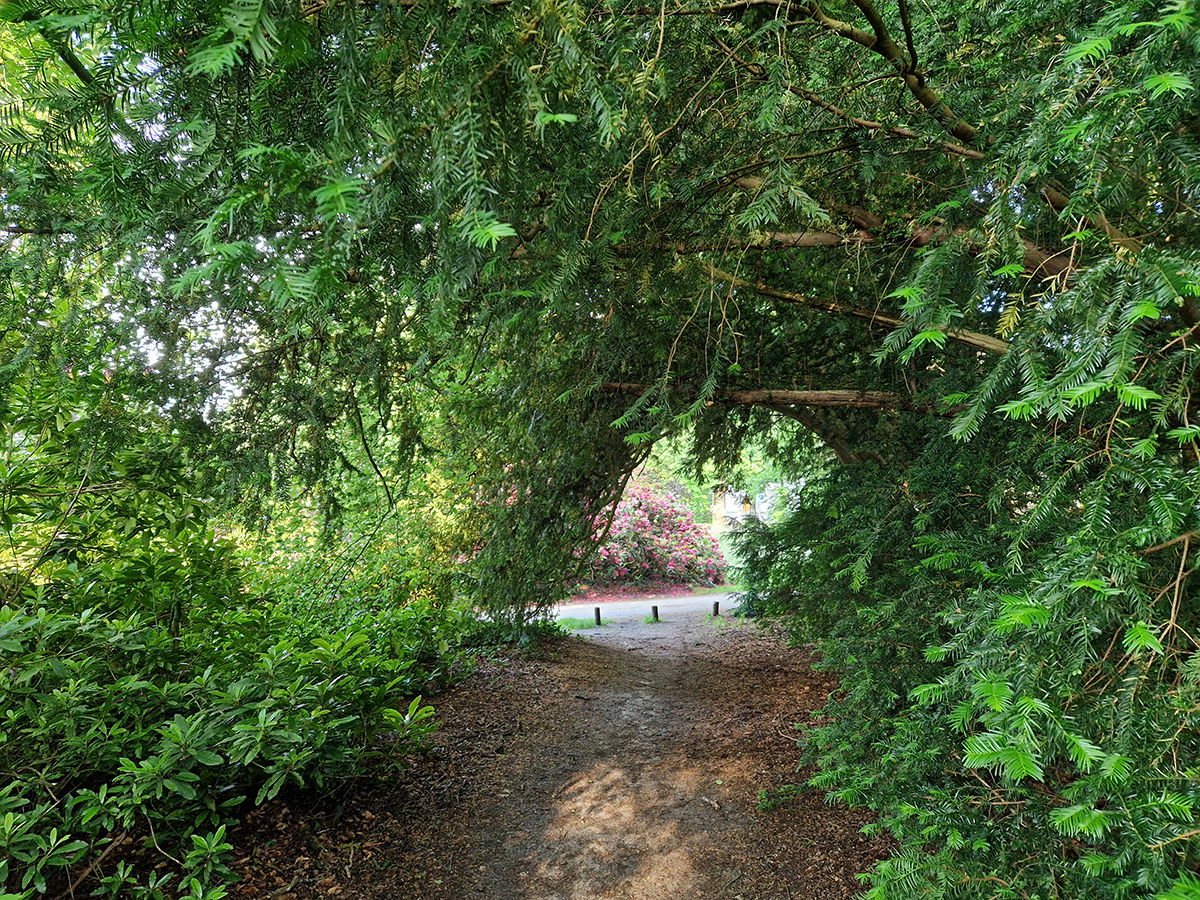
You can find many more beautiful photos in the gallery of the website.
Zeist is so beautiful and how lucky we are to live here.
Until the next walk at the Pavia country estate, Arnie Della Rosa
You can read my walking stories as well as many columns by other Zeister columnists at https://www.zeistermagazine.nl
Brief overview of the country estate Hoog Beek en Royen
Addres: Driebergseweg 1
Hoog Beek en Royen was originally part of the Beek en Royen estate from 1771 and was 330 hectares in size. The original house of this estate at 2e Dorpsstraat 54-58 is still there. The name Beek en Royen is a combination of the names of the founder Hendrik Verbeek (1707-1788) mayor of Utrecht and member of the Utrecht regent patriciate and his wife Clara J. van Royen.
• 1818 Owner: Mr. Coenraad Willem Wijborgh
• 1822 Owner: Evangelical Lutheran community in Berbice
• 1824 Owner: Albert Voombergh (1793-1851) Head of the Amsterdam Banking House Ketwich and Voombergh married in 1821 to young lady Agnes Henriëtte van Loon (1800-1879)
• 1825-1827 construction of a small country house with only one floor “une petite maison de campagne” with the construction of a landscape park and winding pond designed by Jan David Zocher jr. (1791-1870) • 1827 construction of a coach house
• 1828 purchase of an orangery and gardener's house on the Driebergseweg by Albert Voombergh
• 1830 purchase and addition to the park of a strip of land along the Laan van Beek en Royen between Nooitgedacht de Kippenlaan. A house on the other side of the Driebergseweg is being transformed into an orangery.
• 1836 construction of an extra floor on the house
• 1846 renovation of the house and giving it a neoclassical appearance
• 1850 separation of the piece of forest north of the Arnhemse Bovenweg from the country estate Hoog Beek en Royen, creating the new country estate Pavia, 13 hectares in size
• 1851 death of Albert Voombergh • 1875 construction of a playhouse and vegetable garden wall
• 1879 death of young lady Agnes Henriëtte Voombergh-van Loon Eldest daughter Philippina Constantia Isabella Voombergh (1827-1905) married in 1848 to jhr. mr. Jan Willem van Loon (1816-1876) inherits country estate Spar-rendaal
o 2nd daughter Aletta Cornelia Anna Voombergh (1828-1913) married in 1855 to Matthieu Christiaan Hen-drik Ridder Pauw van Wieldrecht (1816-1895) inherits Pavia country estate
o 3rd daughter Henrietta Maria Jacoba Voombergh (1830-1908) married in 1854 to banker Charles Ber-nard Labouchere (1817-1897) lived at the Castle
• 1905 Owner: Eldest daughter and heiress Agnes Henriëtte Constance van Loon (1850-1933)
• 1906 conversion of coach house into coachman's house
• 1941 Owner Utrechts Landschap 1954 rented as official residence of the mayor by the municipality of Zeist
• 1973 Owner: Municipality of Zeist
• 1982 occupied by International College of Business Administration Het Utrechts Landschap remains owner of the estate
• 1977 pond is provided with an artificial bottom and the park is laid out as a public park
• 1988 Owner: Raadgevend Bureau Claesses B.V.
• 1991 Owner: Holding company Diosmo B.V.
• 2001 Owner: Van Lanschot Kempen Bankiers
• 2012: construction of vineyard in former vegetable garden by Rotary in collaboration with Het Utrechts Landschap